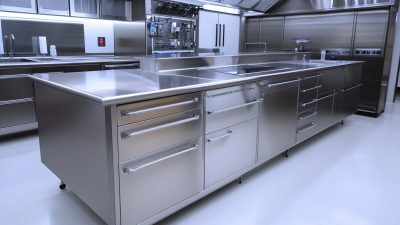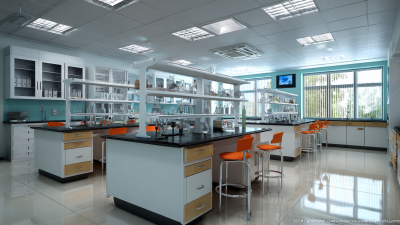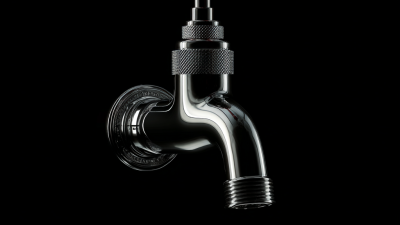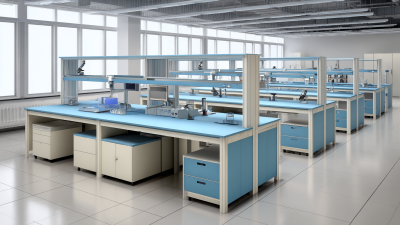In the fast-paced environment of modern laboratories, the choice of fixtures can significantly impact overall efficiency. Among these essential components, the lab sink emerges as a critical element that facilitates seamless workflow and enhances safety. According to a recent industry report by the Laboratory Equipment Manufacturer's Association, 70% of lab accidents stem from improper water handling or inadequate workspace management, highlighting the importance of selecting the right lab sink. As laboratories increasingly adopt advanced technologies and larger scale operations, their sink systems must evolve to meet stringent hygiene standards and accommodate complex tasks. By focusing on seven essential features that define the best lab sinks, we can ensure optimal functionality, safety, and compliance with industry regulations—paving the way for unparalleled laboratory efficiency.

In a laboratory setting, the design of lab sinks plays a crucial role in enhancing workflow efficiency. High-performance lab sinks should incorporate ergonomic features that enable easy access and minimize the need for excessive bending or stretching. Ideal sinks are at an appropriate height to accommodate a range of users, allowing them to work comfortably and efficiently. Moreover, a streamlined layout with strategically placed faucets and accessories reduces clutter and facilitates swift movement, reducing downtime between tasks.
Another essential design element is the use of resistant materials such as stainless steel or chemical-resistant composites, which not only enhance durability but also make cleaning and maintenance much easier. Effective drainage systems should be integrated to manage waste efficiently and to prevent backups, which can disrupt lab activities. Additionally, implementing features like foot pedals or sensor-operated faucets can further optimize hygiene and ease of use, supporting a seamless workflow in high-pressure laboratory environments. These thoughtful designs significantly contribute to overall lab efficiency, ensuring that scientists and technicians can focus on their tasks without unnecessary interruptions.
When selecting lab sinks, the materials utilized in their construction play a critical role in determining both durability and safety. Industry-standard materials such as stainless steel, polypropylene, and epoxy resin offer distinct advantages that adhere to rigorous laboratory requirements. According to a report by the Lab Equipment Manufacturers Association, over 90% of modern laboratories prefer stainless steel for sink fabrication due to its resistance to corrosion, ease of cleaning, and ability to withstand high temperatures. This material not only ensures longevity but also minimizes the risk of contamination, which is paramount in a laboratory environment.
Furthermore, the choice of materials directly impacts safety. For example, the National Institute of Standards and Technology suggests that sinks made from polypropylene can withstand a wide range of chemical exposures without degrading, making them ideal for chemical research labs. In a study by the American Chemical Society, it was found that laboratories using high-quality epoxy resin sinks reported 40% fewer incidents related to chemical spills and accidents due to the material’s non-reactive nature. These findings underscore the importance of selecting appropriate lab sink materials to enhance both operational efficiency and safety in scientific environments.
When it comes to optimizing water flow and drainage in laboratory environments, the design and functionality of lab sinks are critical. One essential feature is the sink’s shape and design, which should facilitate efficient water pooling and drainage. Sinks with rounded edges and sloped bottoms help prevent water stagnation, ensuring that all liquid drains quickly and completely. This is particularly important in laboratories where chemical spills can occur, as it minimizes contamination risks and maintains a safe workspace.
Another significant factor is the choice of materials used in sink construction. Stainless steel is a popular option due to its durability and resistance to corrosion, which is essential in laboratories that work with various reagents. Additionally, having a high-quality drainage system equipped with strainers can prevent clogs and ensure continuous water flow, further enhancing efficiency. Incorporating ergonomic tap placements and efficient control systems also contributes to optimal water management, allowing users to easily adjust flow rates and reduce wastage during experiments. These features collectively create a functional workspace that not only enhances productivity but also upholds safety standards in the lab.

Proper sink design plays a crucial role in enhancing laboratory productivity. Ergonomic considerations are essential, as they can reduce strain on lab personnel and facilitate efficient workflows. A well-designed lab sink allows easy access for all users, minimizing the risk of overreaching or awkward body positioning that can result in fatigue. Additionally, incorporating features like adjustable heights or accessible controls can make a significant difference in how effectively a lab operates.
One important aspect to keep in mind is the proper disposal of chemicals through lab sinks. While it’s tempting to quickly rinse hazardous materials down the drain, strict guidelines must be adhered to in order to protect the environment and public health. Lab managers should ensure that sinks are equipped with proper drainage systems that can handle and neutralize waste safely. Regular training on disposal practices is vital for all lab personnel to avoid unintentional mishaps.
Tips: When selecting lab sinks, consider designs that facilitate easy cleaning and maintenance. Ensure that sinks are placed in locations that streamline workflow, reducing the number of steps taken during experiments. Additionally, integrate labeling systems for chemical disposal to raise awareness and compliance among staff.

When evaluating lab sinks for optimal efficiency, one crucial aspect to consider is cost-effectiveness. Investing in high-quality lab sinks may seem daunting upfront, but the long-term savings they offer can significantly outweigh initial costs. Durable materials resist wear and tear, reducing the need for frequent replacements. This durability minimizes downtime and enhances overall productivity in the lab. Moreover, sinks designed for easy maintenance can lead to further savings by cutting down the time and resources spent on upkeep.
**Tip:** Look for sinks with seamless designs and smooth surfaces, as these features allow for easier cleaning and help prevent the buildup of hazardous materials, reducing long-term maintenance costs.
Additionally, choosing lab sinks that prioritize both functionality and ergonomics can directly impact the efficiency of lab operations. Efficient water flow, strategic tap placements, and ample workspace can improve workflow, allowing researchers to focus on their tasks without interruptions.
**Tip:** Evaluate sink designs that integrate features such as built-in drainage systems and splash guards, ensuring that spills and messes are promptly contained, which further maintains a clean and safe working environment.
This chart illustrates the long-term savings associated with investing in high-quality lab sinks compared to standard models. The data points represent average maintenance costs over a 10-year period, demonstrating how premium sinks can lead to significant savings.






